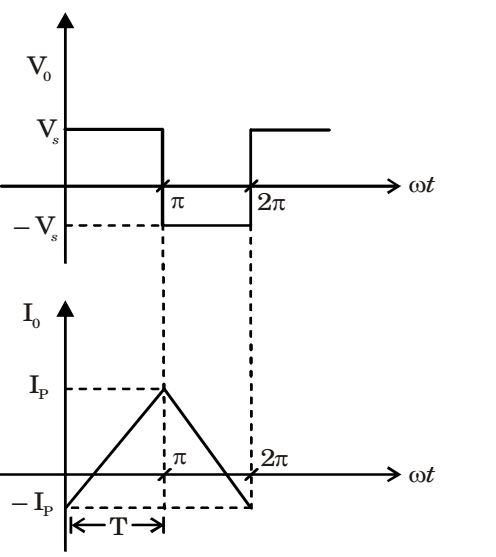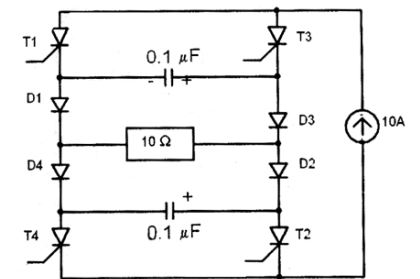Power electronics and drives miscellaneous
- A 220 V 1400 rpm, 40 A separately excited dc motor has an armature resistance of 0.4Ω. The motor is fed from a single phase circulating current dual converter with an input ac line voltage of 220 V (rms). The approximate firing angles of the dual converter for motoring operation at 50% of rated torque and 1000 rpm will be
-
View Hint View Answer Discuss in Forum
At rated speed and torque, E = V – Ia Ra= 220 – 40 × 0.4 = 204 volts
At 1000 rpm and 50% of rated torque, since
T ∝ II2 = 1 × 40 = 20 A 2 ∴ E2 = E1 × N2 N1 = 204 × 1000 = 145.71 volts 1400
∴ Applied Voltage, V2 = E2 + I 2 R2
= 145.71 + 20 × 0.4 = 153.71 volts
Hence output of converter (rectifier 1),V0 = 2Vm cos α1 = 153.71 π ∴ 2 × √2 × 220 cos α1 = 153.71 π
⇒ α1 = 39.1° ≈ 39°
∴ Firing angle of rectifier, α2 = 180 – α1 = 141°
Hence α1 = 39° and α2 = 141°Correct Option: C
At rated speed and torque, E = V – Ia Ra= 220 – 40 × 0.4 = 204 volts
At 1000 rpm and 50% of rated torque, since
T ∝ II2 = 1 × 40 = 20 A 2 ∴ E2 = E1 × N2 N1 = 204 × 1000 = 145.71 volts 1400
∴ Applied Voltage, V2 = E2 + I 2 R2
= 145.71 + 20 × 0.4 = 153.71 volts
Hence output of converter (rectifier 1),V0 = 2Vm cos α1 = 153.71 π ∴ 2 × √2 × 220 cos α1 = 153.71 π
⇒ α1 = 39.1° ≈ 39°
∴ Firing angle of rectifier, α2 = 180 – α1 = 141°
Hence α1 = 39° and α2 = 141°
- A single phase fully controlled converter bridge is used for electrical braking of a separately excited dc motor. The dc motor load is represented by an equivalent circuit as shown in the figure given below.

Assume that the load inductance is sufficient to ensure continuous and ripple free load current. The firing angle of the bridge for a load current of I0 = 10 A will be
-
View Hint View Answer Discuss in Forum
For continuous conduction Average load current (by KVL),

Vt – 2Ia + 150 = 0∴ I = Vt + 150 = 10 A 2
⇒ Vt + 150 = 20⇒ 2 Vm cos α = -130 π ⇒ 2 × √2 × 230 × cos α = -130 π
⇒ α = 129°Correct Option: C
For continuous conduction Average load current (by KVL),

Vt – 2Ia + 150 = 0∴ I = Vt + 150 = 10 A 2
⇒ Vt + 150 = 20⇒ 2 Vm cos α = -130 π ⇒ 2 × √2 × 230 × cos α = -130 π
⇒ α = 129°
- A single phase voltage source inverter is feeding a purely inductive load as shown in the figure given below.

The inverter is operated at 50 Hz in 180° square wave mode. Assume that the load current does not have any dc component. The peak value of the inductor current i0 will be
-
View Hint View Answer Discuss in Forum

T = π = π = 1 = 0.01 sec ω 2π50 100
And, for 0 < ωt < π,V0 = L di dt ⇒ 200 = 0.1 
IP - (-IP) 
T
⇒ 2IP = 2000T
⇒ IP = 10 Amps
Correct Option: B

T = π = π = 1 = 0.01 sec ω 2π50 100
And, for 0 < ωt < π,V0 = L di dt ⇒ 200 = 0.1 
IP - (-IP) 
T
⇒ 2IP = 2000T
⇒ IP = 10 Amps
- The Current Source Inverter shown in the figure given below is operated by alternately turning on thyristor pairs (T1, T2) and (T3, T4). If load is purely resistive, then theoretical maximum output frequency obtainable will be

-
View Hint View Answer Discuss in Forum
Let T3 and T4 already conducting at t = 0
Now, trigger T1 and T2, so T3, T4 force commutated.
Now capacitor start to discharge, becomes zero. Now charge with opposite polarityAt t = T , trigger T3, T4 2
So T2, T1 force commutated.
Now capacitor start to discharge, becomes zero and now charge with positive polarity
This completes one cycle
Time constant, = τ = RC = 0.5μs
∴ Total τ = 4 × τ = 4 × 0.5 μs = 2 μs∴ f = 1 = 1 = 500 kHz T 2 × 10-6 Correct Option: C
Let T3 and T4 already conducting at t = 0
Now, trigger T1 and T2, so T3, T4 force commutated.
Now capacitor start to discharge, becomes zero. Now charge with opposite polarityAt t = T , trigger T3, T4 2
So T2, T1 force commutated.
Now capacitor start to discharge, becomes zero and now charge with positive polarity
This completes one cycle
Time constant, = τ = RC = 0.5μs
∴ Total τ = 4 × τ = 4 × 0.5 μs = 2 μs∴ f = 1 = 1 = 500 kHz T 2 × 10-6
- In the voltage doubler circuit shown in the figure, the switch ‘S’ is closed at t = 0. Assuming diodes D1 and D2 to be ideal, load resistance to be infinite and initial capacitor voltages to be zero, the steady state voltage across capacitors C1 and C2 will be

-
View Hint View Answer Discuss in Forum

First capacitor C1 will charge through diode D1 upto Vmax (5 V) with shown polarity
∴ VC1 = 5 V
Now, diode D1 will be reverse biased and D2 will be forward biased and capacitor C2 will charge in reverse direction through diode D2 upto 2Vmax
∴ VC2Hence, VC1 = 5 V1, VC2 = 10 VCorrect Option: C

First capacitor C1 will charge through diode D1 upto Vmax (5 V) with shown polarity
∴ VC1 = 5 V
Now, diode D1 will be reverse biased and D2 will be forward biased and capacitor C2 will charge in reverse direction through diode D2 upto 2Vmax
∴ VC2Hence, VC1 = 5 V1, VC2 = 10 V

